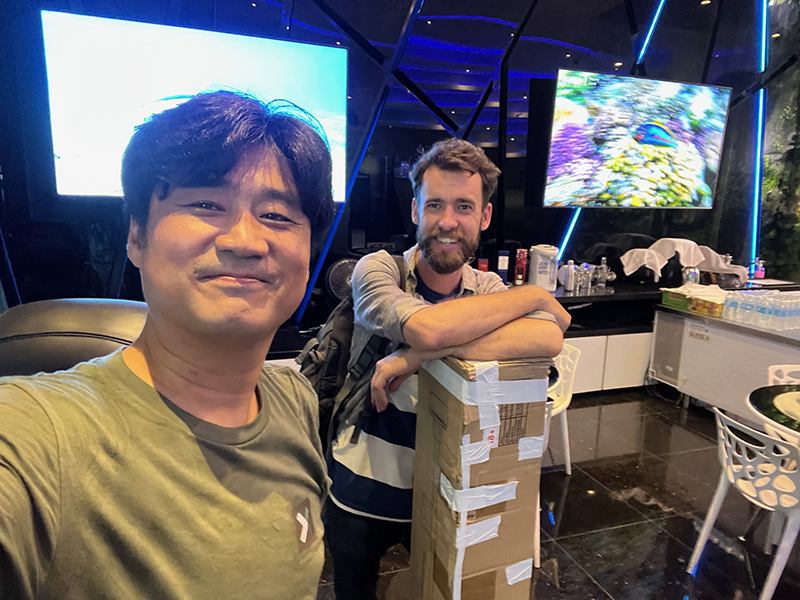Purdue Digital Forestry team advances to $10 million XPRIZE Rainforest competition finals
Purdue University competitors for XPRIZE Rainforest, a global cross-disciplinary challenge of monitoring tropical biodiversity, and their Illinois Institute of Technology teammates endured some tense moments in the semifinals, held in Singapore earlier this year.
But after overcoming multiple challenges, including a nail-biter in the last minutes of the competition, the team recently learned it has qualified to compete in next year’s $10 million XPRIZE Rainforest finals. Team Welcome to the Jungle, led by Illinois Tech’s Matthew Spenko, professor of mechanical and aerospace engineering, also includes members from Natural State and the Morton Arboretum.
Natural State developed artificial intelligence and machine learning models to automatically identify animal species from Illinois Tech’s sound and video recordings. Morton Arboretum used Purdue’s aerial images to identify tree species.
“Working collaboratively, our team has been able to obtain crucial insights about the health and biodiversity of the rainforest,” said Jinha Jung, associate professor in the Lyles School of Civil Engineering. “Our joint efforts illustrate the power of interuniversity collaboration in addressing critical environmental challenges.”
Jung is a member of Purdue’s Institute for Digital Forestry. One of the five strategic initiatives in Purdue’s Next Moves, the institute leverages digital technology and multidisciplinary expertise to measure, monitor and manage urban and rural forests to maximize social, economic and ecological benefits.
Among the many teams that initially entered the five-year XPRIZE Rainforest competition, 36 teams competed in the qualifying round, with 13 advancing to the semifinals. The Illinois Tech-Purdue team was one of only two that were able to seamlessly cover the entire 60 hectares (about 150 acres) of rainforest in the semifinal test area.
The Purdue members of the team led the aerial surveying to measure vegetation, identify canopy trees, quantify tree species diversity and determine potential sensor deployment locations. The Purdue team consists of Jung, along with Joshua Carpenter and Hansae Kim, both PhD students in Jung’s Geospatial Data Science Lab. Kim contributed to the data analysis portion of the competition remotely from West Lafayette.
The 13 semifinalist teams had 24 hours to collect as much biodiversity data as possible in a natural rainforest area in the middle of urban Singapore, and another 48 hours for analysis.
“Not everything went smoothly. There were many challenges,” Jung said. Many of the challenges arose during the data-collection period. Members of the Illinois Tech robotics group had developed sensor packages that they dropped into the forest canopy with a drone. Each of the team’s five sensor packages contained a sound recorder and a video device.
Jung and Carpenter, meanwhile, flew their drones to take multispectral and natural color imagery of the canopy. “We had quite a bit of trouble figuring out a safe way to autonomously run our drones,” Carpenter said. They ended up following a path that, because of the forest canopy, unavoidably meant periodically losing radio connection with the drone while it flew on its own.
“We could expect it to get close enough for a connection about once every two or three minutes,” Carpenter said. During those nerve-racking minutes, they had no idea about the drone’s status. “It could have crashed. We’re sitting there just waiting, waiting, waiting for the radio signal to come back.”
Jung’s group has successfully flown drones in dense forests previously. “Before we always had the freedom to go where we want to take off so that we can consistently maintain line of sight and the signal,” he said. But competition rules required them to work within a specified area covered by a dense rainforest canopy that blocked the drone’s signal.
Locating and retrieving all five of Illinois Tech’s deployed sensor packages from the forest canopy triggered another traumatic moment. Contest rules required that all deployed equipment needed to be retrieved at the end of the data-collection period to keep the rainforest pristine. But initially, the team could locate and retrieve only four of the packages.
Suddenly, with about 15 minutes left on the clock, the team figured out the likely location of the missing package. Within about 10 minutes, the team spotted the package, collected it with a drone and returned it to base camp.
“With five minutes on the clock, we were able to retrieve everything that was deployed. We were really pumped about that,” Carpenter said.
The format for the final contest will be similar to the semifinals, but in a more remote and challenging location. The winning team will survey the most biodiversity contained in 100 hectares (247 acres) of tropical rainforest in 24 hours and produce the most impactful real-time insights within 48 hours. The other five finalists are teams based in New Haven, Connecticut; Grand Junction, Colorado; Piracicaba, Sao Paulo, Brazil; Barcelona, Spain; and Zurich, Switzerland.
“We have a unique set of skills that allow us to be highly impactful,” Carpenter said. “We team up with people who have the scientific knowledge. When we have the chance to bring those skills to bear to help improve the world, we want to do it.”
Learn more about XPRIZE Rainforest and stay up to date on the competition at xprize.org/rainforest.








